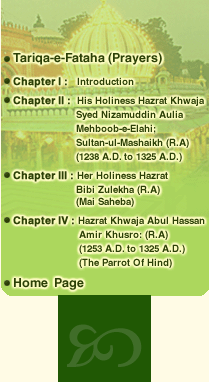(3) Path
of Sufism
He and His Holiness Hazrat Syed Nizamuddin
Aulia (R.A) shared the same passion for music. Amir Khusro
was a noble man, Sufi Saint and a Faqir. He was the founder
of many musical instruments and Urdu. According to Mir Khurd,
that all the Qawwals of the city used to come at his Jamat
Khana and in his guidance they raised music to the height
of a sublime art. They gave new flavour and vitality to
the ghazals. Thus they raised the art of music to the level
of a spiritual discipline.
Hazrat Amir Khusro (R.A) became His
Holiness favourite disciple and wrote about his teachings.
He followed the middle path; never abandoned his courtly
life; but moved towards practices of tasawwuf (Sufism).
He spent most of the time in writing Khamsa.
The first of this series of Masnavi
called "Khamsa-e-Khusrawi" is his Matla-ul-Anwar. This Masnavi
was composed by Amir Khusro in 697 A.H/1297 A.D written
within two weeks. In this Masnavi, Amir Khusro has expounded
his views and attitudes towards Shariat, Tareeqat and Haqeeqat.
According to him "Shara" acquires meaning when it maintains
a close relation with reality i.e. when it partakes the
essence of reality-love of God! If Shara is taking in or
in other words if it is without "Ain" (i.e. the essence
of God love) it becomes Shar (evil). Similarly his attitude
towards the Sufis, of his time was very critical. It is
worth quoting in this connection a few lines from his Masnavi,
"Matla-ul-Anwar."





